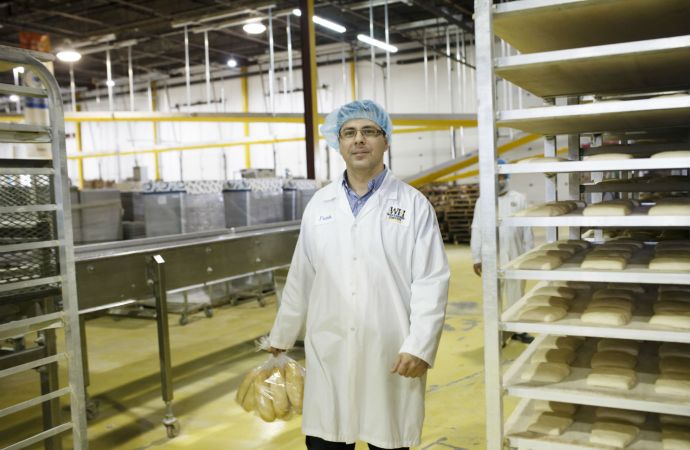Impressed by its safety, environmental friendliness and energy efficiency, Wholesome Harvest Baking is the first industrial operator in Canada to install Mayekawa’s NewTon NH3/CO2 system.

Frank Barrese, Wholesome Harvest Baking
What makes a company decide to invest in a refrigeration system never before tried in its country?
Last September, Wholesome Harvest Baking, a division of Mexican baking giant Grupo Bimbo, became the first company in Canada to operate the NewTon, Mayekawa’s ammonia/CO2 packaged refrigeration system, in an expansion of a bread-making plant in the Etobicoke section of Toronto. The project included the refrigeration system, a spiral freezer, installation and building modifications.
The NewTon is one of a growing breed of low-charge ammonia packaged refrigeration systems that keep the ammonia charge well below the 10,000-lb. threshold triggering greater regulatory scrutiny. The factory-made system uses the ammonia to condense gaseous CO2, which is the only refrigerant providing the cooling in operating areas.
The NewTon has established a considerable track record outside of North America, particularly in Mayekawa’s home market of Japan, where many of the more than 1,000 NewTon installations worldwide are located. Mayekawa is installing the NewTon at the rate of about 300 per year, mostly in cold storage and food processing facilities, said Len Puhacz, sales manager, green systems, at Mayekawa’s Toronto office.
In North America continent, Mayekawa has partnered with Toronto-based CIMCO Refrigeration to market the NewTon. So far the companies have deployed one other NewTon at an operating facility – an Imuraya confectionary plant in Irvine, Calif. The Garden City Ammonia Program (GCAP), a training facility in Garden City, Kan., has also installed the NewTon, but only for training purposes.
The Etobicoke plant is one of three facilities that Wholesome Harvest operates in the Toronto area, along with one other in Calgary, Canada, and three in the U.S. The Etobicoke facility runs two 45-TR NewTon F-600 packaged NH3/CO2 units, each with two ammonia compressors, 120 lbs. of ammonia and about 1,150 lbs. of CO2; the units serve as the freezing agent for a spiral freezer added to the existing facility. CIMCO handled the installation of the refrigeration system.
The Etobicoke plant is the kind of mid-sized food processing facility suitable for the NewTon, said David Fauser, Ontario sales manager for CIMCO, who worked with Wholesome Harvest on the NewTon project. Mayekawa sees a great opportunity for the NewTon in North America as a replacement for R22 systems in those facilities as R22 enters the final chapter of its phase-out, said Puhacz. The same opportunity would apply to HFC systems once the HFC phase-down accelerates. Large plants that would normally employ direct ammonia systems represent another target; in Japan, such plants have installed up to 12 NewTons.
Walking the talk
Part of the appeal of the NewTon to Wholesome Harvest Baking resides in its environmental friendliness. In contrast to HFC condensing units, the NewTon’s working fluids, ammonia and CO2, are natural refrigerants. If they escape they “return to nature; there’s zero impact to the environment,” said Frank Barrese, engineering and maintenance manager for Wholesome Harvest’s Etobicoke plant. He was recognized for his work on the NewTon installation with a President’s Award from Wholesome Harvest.
Moreover, the NewTon’s energy efficiency is far greater than that of an HFC system, further reducing greenhouse gas emissions.
The [conventional] ammonia systems we purchase are safe, but the NewTon gives an added measure of safety.”
– Frank Barrese, Wholesome Harvest Baking
Grupo Bimbo also emphasizes sustainability in its corporate policies. “Companies may state they have strong environmental and safety policies” said Barrese. “Grupo Bimbo is committed to these policies as it is demonstrating though this investment.”
“Grupo Bimbo seems focused on environmental sustainability as part of their business case,” said Fauser, adding: “I feel really lucky that I was involved with this.”
Wholesome Harvest opted not to install a conventional direct-ammonia overfeed system – which would have been slightly less expensive than the NewTon with about the same efficiency – for safety reasons. Unlike a conventional system, the two NewTon units use a small amount of ammonia and confines it to the mechanical room, preventing any potential exposure of the gas to employees. “The [conventional] ammonia systems we purchase are safe, but the NewTon gives an added measure of safety,” said Barrese.
Puhacz noted that safety has been a major driver of the NewTon’s adoption overseas. “The attraction is that it’s green without using ammonia in the storage space.”
Enclosed in the NewTon units, liquid ammonia goes into a plate-and-shell heat exchanger where it condenses CO2 gas returning from the spiral freezer evaporators. The liquid CO2 is then pumped to, and across, the roof, and down into the freezing room, about 45 feet from the mechanical room. The now gaseous ammonia is liquefied by glycol in another plate-and-shell heat exchanger inside the NewTon units. (The glycol regains its low temperature from a water tower on the roof.) “The ammonia never leaves the mechanical room,” emphasized Barrese.
At the Etobicoke plant, redundancy was built into the two-NewTon, four-compressor design so that the system would run “as continuously as possible,” noted Barrese. “We can still maintain the temperature with one of the compressors down.” But to ensure that the CO2 gas continues to be condensed if more than one of the ammonia compressors fails, CIMCO installed a back-up 7-TR R404A condensing unit. “So, if there’s any interruption, the [HFC] unit takes over from the ammonia compressors to keep the CO2 cool. Everything is automatic.”
Ease of use is a key aspect of the NewTon. In adding spiral freezing to the Etobicoke plant, Wholesome Harvest wanted to employ a refrigeration system that would be comfortable for longtime employees to run. The NewTon, with its “one-button-type” operation and intuitive controls matched that description, running continuously even under different loads, said Barrese. “We were very careful to make the equipment a good fit to the people and the culture. It’s peace of mind for me, our managers and Wholesome Harvest Baking.”
“It runs itself,” added Fauser.
Efficiency winner
The NewTon has a reputation for energy efficiency; this was born out at the Etobicoke plant in a study conducted by I.B. Storey, a third-party energy consultant, to qualify Wholesome Harvest for an energy incentive. The study compared the NewTon to an HFC system.
“As an indirect ammonia system, the NewTon is close to the same energy efficiency as a direct ammonia system, without any of the hazards of direct ammonia,” said Barrese. “And it’s heads and tails more efficient than Freon.” Fauser pointed out that the NewTon minimizes the energy penalty normally associated with an indirect system that uses two refrigerants. “That’s what makes it so unique.”
As its baseline, I.B. Story estimated the annual energy performance of a standard HFC refrigeration system by using energy metering of its compressors during a 28-day period. A similar estimate was done for the NewTon. The conclusion: The NewTon generated 588,063 kWh annually, compared to 1,200,931 kWh for the conventional HFC system, a savings of 612,268 kWh. In addition, the annual savings in peak energy consumption achieved with the NewTon was 122 kW. Based upon these savings, I.B. Story recommended an energy incentive from the SaveONenergy Retrofit Program run by Toronto Hydro-Electric System, which conditionally approved the application in late January.
The NewTon is monitored remotely from Mayekawa’s Japanese headquarters, which does predictive maintenance. “If they see something and we choose to ignore it, they’ll still be knocking on your door,” said Barrese. Fauser noted that the NewTon is very low-maintenance and leak-tight, while Puhacz pointed out that the NewTon’s compressors have no shaft seals, making them less likely to leak.
Though the NewTon is a new technology for Barrese, he has worked with Mayekawa and its Mycom compressor brand during his 10-year career at Wholesome Harvest/Canada Bread. “I’ve refurbished compressors using Mycom,” he said. I understand Mycom and I know the quality of their work; it’s fantastic.” He has also successfully collaborated with CIMCO on integrating and commissioning Mycom equipment. Consequently. Barrese had “absolutely no concerns” about being the first Canadian user of the NewTon.
Barrese also praised Mayekawa’s customer service. During the commissioning process, Mayekawa “made sure [the NewTon] was working 100% the way we needed it to work,” he said, echoing the philosophy Mayekawa describes on its website. “In most cases, they have a better understanding of what we need than we do ourselves.” At his request, Barrese was given a visual diagram of all of the components of the NewTon. “They said, ‘we’ve never done that before, but if that’s what you want we’ll do it for you.’”
In North America, the NewTon follows in the footsteps of other low-charge packaged ammonia systems offered by NXTCOLD, Evapco, Azane, Stellar and CIMCO. Some operators are reducing the ammonia charge in conventional industrial systems using DX coils or other methods. In addition, M&M Refrigeration has installed large-scale ammonia/CO2 systems for cold storage operators like U.S. Cold Storage.
But for a spiral freezer application, “there’s not a better solution [than the NewTon] if you don’t want ammonia in the plant,” said Fauser.
For more on Wholesome Harvest Baking and the NewTon, read the cover story in the February issue of Accelerate America magazine.
Related stories



